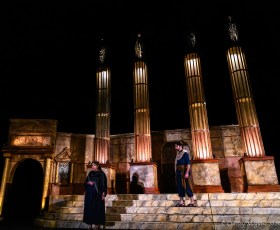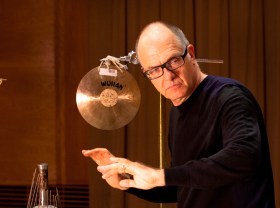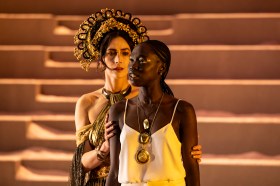Ilyich Rivas, conductor. Image via Melbourne Recital Centre.
The Australian National Academy of Music (ANAM) completed its season of concerts in 2016 with an orchestral performance to a nearly full Elisabeth Murdoch Hall on Friday night. Alumni, distinguished guest musicians and faculty sprinkled throughout the orchestra keeping a watchful eye over each section joined ANAM students to form a formidable ensemble of 84 musicians. The ANAM Orchestra (with violas to the right of the podium and cellos in the centre) was directed by the 23-year-old Venezuelan-American conductor, Ilyich Rivas. What an amazing talent he is; never showy or self-obsessed, a faultless technique with the beat always on the tip of his baton, expressive, disciplined and paying great attention to rhetorical detail throughout. Rivas found a blend that sounded as though the ensemble had played together for years, tuning and rapport was excellent throughout. Three works were programmed: Igor Stravinsky’s The Firebird Suite (the ballet was composed in 1909-10 and revised into a five movement suite in 1919), Alberto Ginastera’s rarely performed Piano Concerto No 1, Op 28 (1961) with Timothy Young (ANAM’s head of piano) as soloist and Pyotr IlyichTchaikovsky’s large-scaled Symphony No 5 in E minor, Op 64 (1888). I wondered if Rivas had been named after the last composer.
From the opening lower string ruminations of the Introduction, Stravinky’s The Firebird had all of the excitement of an actual staged ballet performance. The first display of the Firebird and its cavorting waltz startled. The Princesses’ Khorovod (Rondo, round dance) with cushioned strings delighted for its magical light and shade; woodwind and cello solos were excellent. The opening whack! of the Infernal dance of King Kashchei ricocheted off the walls as the monsters under the firebird’s spell dance with a visceral rhythmic thrust as, countered by the elegant dream music of the Berceuse (Lullaby), the magical creatures of the Koschei fall asleep. Here a true pianissimo was found, almost inaudible in the fine acoustic of the Elisabeth Murdoch Hall. The hymn-like Finale was introduced with an uncertain horn solo while the large and long crescendo followed where the Princesses are awakened from their sleep and are freed at last.
Argentine composer Ginastera’s first Piano Concerto comes from his final ‘Neo-Expressionist’ period and was commissioned by the Koussevitzky Foundation. The work is highly chromatic, sometimes using tone rows, but mostly tonally supported. Presenting ballet of a different order, the work is full of display and flourish with plenty of drive and excitement, its textures competent and varied. What concerned me over its four movements and nearly half-hour duration was that it ultimately seemed directionless and its musical material not strong enough to sustain interest. Young was an excellent soloist throughout, however, displaying virtuosity and a close familiarity of the score. The opening Cadenza e varianti with its delicate pointillistic treble material over shimmering strings contrasted with more brutal sections that sounded like a kind of balletic brawl. Young played with a commitment that convinced though some of the octave passages were smudged. The Scherzo allucinante with its fragile harmonics felt insubstantial. The Adagissimo opened with an excellent viola solo leading to further anxious outbursts; the movement well and truly overstayed its welcome. The Toccata concertata sounds like Argentinian Bartók with more ‘bash, crash and smash’ to the enticing punching rhythmic drive of the malambo, a foot-stomping dance popular amongst Argentine cowboys.
The ANAM Orchestra then delivered a fine reading of Tchaikovsky’s fifth symphony, brimming with Romantic pathos and sympathetic to the broad Russian balletic grandeur of this great composer’s aesthetic. This substantial work is structured around a recurring main theme (sometimes dubbed the ‘fate theme’) heard at the outset as a funeral march. My seat being near the front to the extreme right of the Hall, I could not be sure, but it seemed as if more upper strings (on the extreme left) were required. The pace set for the tragic second movement (Andante cantabile, con alcuna licenza) was perfect and the famous horn solo superbly played. Strings provided a glorious body of sound in the Valse: Allegro moderato. The Finale: Andante maestoso (con fiamma) was thrilling.
So often one hears well-known works such as this performed by professional orchestras as routine chore. Here though there was real emotional investment from these young musicians. Music was made.
Rating: Four stars out of five
ANAM Orchestra
Ilyich Rivas conductor
Timothy Young piano
Presented by the Australian National Academy of Music
Elisabeth Murdoch Hall, Melbourne Recital C entre
11 November 2016





